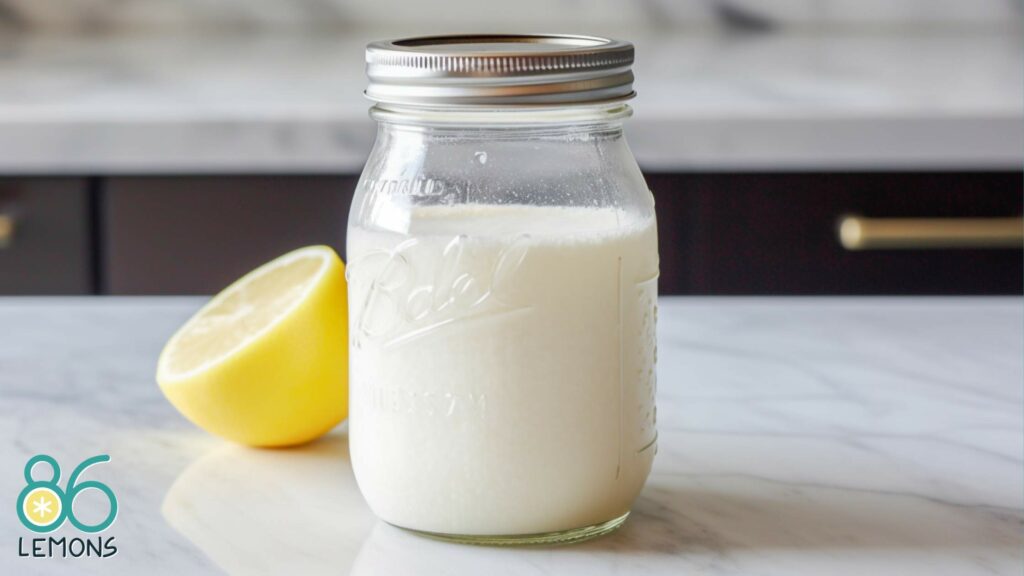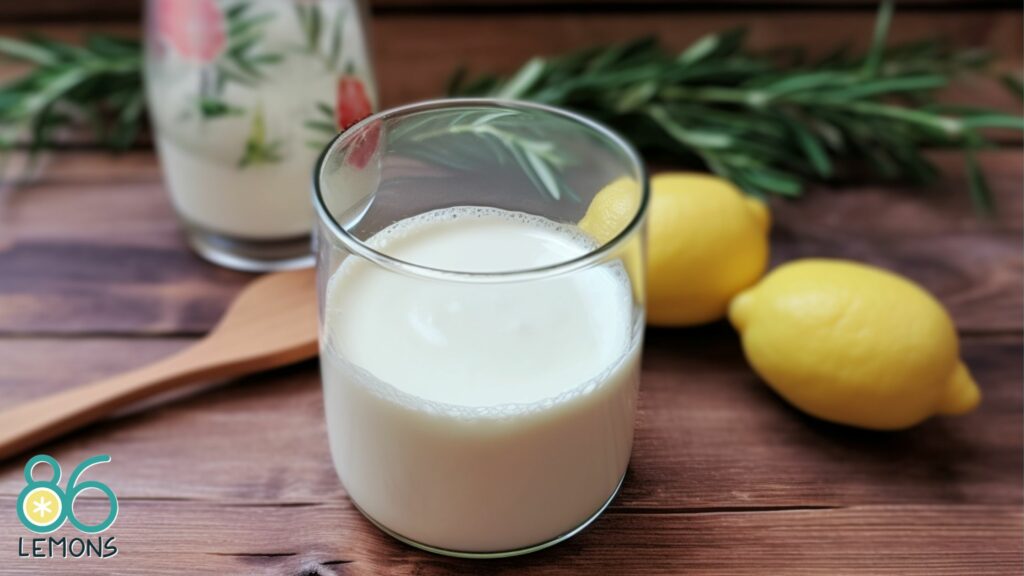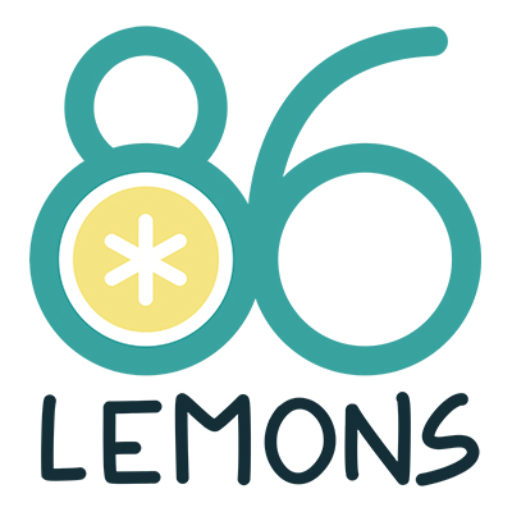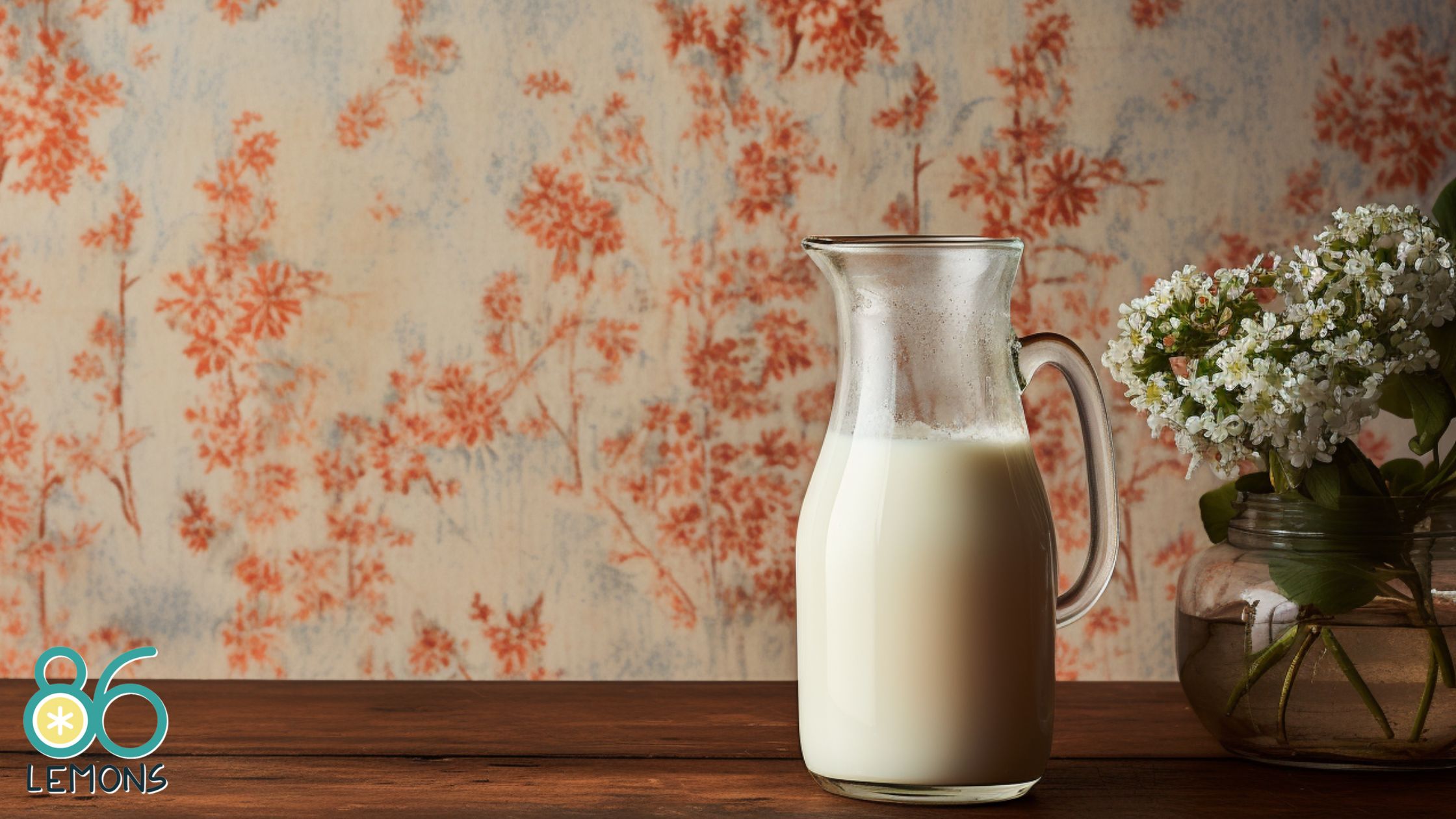Making vegan buttermilk at home is a breeze, and it’s a game-changer for your vegan cooking. The beauty of a vegan buttermilk substitute lies in its simplicity—you only need two ingredients: plant milk and an acid. When mixed, these ingredients emulate the tangy flavor and tenderizing qualities of traditional buttermilk without any animal products.
Whether you’re whipping up pancakes on a Sunday morning or preparing a batch of fluffy biscuits, having homemade vegan buttermilk on hand ensures that your vegan dishes retain the moistness and richness that buttermilk provides.
And the best part? You can make it with your favorite plant milk, be it almond, soy, oat, or any other variety. It’s all about finding the perfect combination to suit your taste and recipe needs.
Understanding Vegan Buttermilk
Vegan buttermilk is a dairy-free alternative to traditional buttermilk, bringing a tangy twist to your vegan baking and cooking. It’s easy to whip up at home with just a couple of ingredients.
Defining Vegan Buttermilk
Vegan buttermilk is simply a plant-based milk that’s been combined with an acid to mimic the taste and consistency of traditional buttermilk. You typically use unsweetened, plain, dairy-free milk like almond or oat milk and mix it with an acid such as fresh lemon juice or apple cider vinegar.
The Role of Acidity in Vegan Buttermilk
Acidity is key in making vegan buttermilk; it’s what causes the plant-based milk to curdle. This curdling process thickens the milk and gives it a rich, creamy texture similar to traditional buttermilk.
The acid you choose, be it lemon juice or vinegar, interacts with the proteins in the milk, causing them to unfold and bind together, thus creating the curdled effect.
Benefits of Homemade Vegan Buttermilk
Opting to make your own vegan buttermilk has a few perks. For starters, it’s customizable—you can adjust the level of acidity to suit your taste preferences. Plus, by preparing it at home, you’re using fresh, simple ingredients without the additives found in some store-bought versions.
Homemade vegan buttermilk is cost-effective and allows you to create just the right amount for your recipe, reducing waste. It’s useful in a variety of dishes, enhancing flavor and moisture in vegan baked goods especially.
Choosing Your Base Liquid
When making vegan buttermilk, your base liquid can dramatically affect the flavor and texture. You’ll want to pick a non-dairy milk that not only tastes great but will also react well to the acid you’ll be adding for that classic buttermilk tang.
Almond Milk: A Popular Choice
Almond has many uses in a vegan kitchen (you can even make almond butter!). Almond milk is a fantastic go-to for your vegan buttermilk. It’s readily available, has a mild flavor, and gives a light texture that works in most recipes. Remember, though, it’s on the thinner side compared to other milks.
Soy Milk: Protein-Rich Alternative
Looking for a bit more body and a protein boost? Soy milk is your friend here. It’s thicker than almond milk and holds up well in the curdling process, making for a richer vegan buttermilk.
Coconut and Oat Milk: Creamy Options
If you’re after something creamier, both coconut and oat milk are excellent choices. Coconut milk adds a tropical hint, while oat milk is naturally sweet and hearty. These can offer a more luxurious mouthfeel to your dishes.
Using Other Non-Dairy Milks
Don’t stop there—cashew milk and other non-dairy options are also on the table. They all bring their own unique qualities to your vegan buttermilk, so feel free to experiment to find your favorite blend.
Mixing Your Acid
The acid you choose is crucial for creating that signature tangy taste in your vegan buttermilk. You’ll combine it with plant-based milk to get the right consistency and flavor.
Lemon Juice: A Fresh Twist
Using lemon juice gives your vegan buttermilk a bright, fresh flavor. You’ll need about 1 tablespoon of lemon juice per cup of non-dairy milk. Mix them together and let the mixture sit for a few minutes to curdle nicely.
Apple Cider Vinegar: A Tangy Addition
Apple cider vinegar is a great option for a tangier vegan buttermilk. Similar to lemon juice, mix 1 tablespoon with a cup of your preferred dairy-free milk. Apple cider vinegar also brings additional benefits, like probiotics.
White Vinegar: A Pantry Staple
Don’t underestimate the power of white vinegar. It’s a common household item that’s perfect for making vegan buttermilk. Simply stir in 1 tablespoon with one cup of milk and let it work its magic.
Experimenting with Other Acids
Feel free to get creative. Your kitchen might hide other acids like citric acid from citrus fruits or even vinegars like balsamic. Keep the ratios similar, and expect each to impart its unique flavor to your buttermilk.
Creating the Buttermilk Mixture
When making vegan buttermilk, it’s essential to nail the ratio of acid to plant milk and achieve the texture that’s just right for your baking and cooking needs. You’re aiming for a slightly curdled, thickened liquid that closely mimics traditional buttermilk.
Perfecting the Vegan Buttermilk Ratio
For your vegan buttermilk to work like magic in recipes, you’ll want to mix 1 tablespoon of acid—lemon juice or apple cider vinegar—with 1 cup of dairy-free milk like almond or soy milk. Stick to this ratio: It ensures the proper balance of acidity and tanginess needed to make your vegan baked goods rise and taste great.
Tips for Achieving the Right Consistency
Once you’ve mixed your acid with the plant milk, let it sit at room temperature for about 10 minutes. Within this time, you should see your mixture curdle and thicken somewhat – that’s a good sign!
If you’re after a thicker consistency, let it sit a bit longer; soon, you’ll have homemade vegan buttermilk that rivals the real deal. Remember, patience and temperature play key roles in helping the mixture reach the desired thickness.
Using Vegan Buttermilk in Recipes
Vegan buttermilk acts much like traditional buttermilk, adding richness and tenderness to a variety of dishes. Whether you’re baking or creating dressings, its acidic nature works wonders in vegan recipes.
Baking Fluffy Vegan Pancakes and Waffles
When you’re aiming for fluffy pancakes or light waffles, vegan buttermilk is your secret ingredient. The acid reacts with baking soda, creating bubbles that give your pancakes that sought-after rise. Just swap out regular milk with a vegan buttermilk mixture for a plant-based version of your morning favorites.
Creating Tender Vegan Biscuits and Cornbread
Want your biscuits to melt in your mouth and cornbread to crumble just right? Add vegan buttermilk to impart a tenderness that’s hard to beat. For biscuits that rival any diner’s, incorporate vegan buttermilk to ensure they’re soft and fluffy inside while retaining a crisp exterior.
Enhancing Vegan Cakes and Brownies
Give your cakes and brownies a moist, rich texture with vegan buttermilk. The acidity improves the crumb and can help balance the sweetness, which is especially nice in chocolate recipes. A vegan buttermilk blend is perfect for making decadent chocolate cakes and gooey brownies that will leave everyone asking for your secret.
Versatility in Savory Dishes and Dressings
Vegan buttermilk isn’t just for sweets; it’s excellent in savory dishes, too. Use it in your vegan ranch dressing for a creamy texture and tangy flavor. When making savory muffins or vegan dressings, vegan buttermilk can replace dairy buttermilk one-for-one, bringing all the zesty character without the dairy.
Storing Your Vegan Buttermilk

After you’ve made your vegan buttermilk, proper storage is key to maintaining its freshness and tangy flavor. Let’s walk through the best ways to keep it in tip-top shape, whether you’re using it soon or saving it for later.
Refrigerating for Short-Term Use
Keep your vegan buttermilk in the fridge if you plan to use it within a week. Pour it into a sealable container or a mason jar to maintain freshness and avoid absorbing other odors. Make sure the lid is tight!
Freezing for Long-Term Storage
For storage extending beyond a week, freezing is your best bet. Vegan buttermilk freezes well, so pour it into ice cube trays for easy portioning later on, or use a freezer-safe container for larger quantities. Be sure to label the freezer bag or container with the date so you can track its storage time.
Best Containers for Preservation
Selecting the right container is crucial for preserving vegan buttermilk’s quality. Mason jars with airtight lids are perfect for the fridge and can go in the freezer as well. Alternatively, heavy-duty freezer bags can save space and protect your buttermilk from freezer burn.
Advanced Tips and Tricks

When you’re aiming to take your vegan buttermilk to the next level, focus on enhancing the flavor and adapting the recipe for various dietary needs.
Enhancing Richness and Flavor
If you’re after a richer taste, try whisking in a small dollop of vegan butter, which provides a creamier consistency and a buttery note. You can use these for sweets like brownies or do it as a twist for your vegan pudding!
For an even luscious twist, stir in a spoonful of vegan whipped cream before the mixture sets. This approach adds a subtle sweetness and a decadent mouthfeel that replicates traditional buttermilk closely.
Alternatives for Special Diets
For those of you with gluten-free needs, ensure the plant-based milk you use is certified free of gluten. Alternatively, if you’re looking to replicate the tangy kick of lactic acid found in dairy buttermilk without the lactose, a pinch of baking powder mixed with a squeeze of lemon can help achieve that familiar lift in your pancakes and biscuits.
Making Vegan Buttermilk Baking Mixes
Creating vegan buttermilk baking mixes is a snap. Just combine your vegan buttermilk with a pre-mixed dry blend of flour, baking powder, and any other leavening agents.
For a richer mix, consider adding powdered vegan condensed milk for extra body and sweetness. Store your mix in an airtight container, and you’ll have the perfect start to a quick and easy vegan treat anytime.
Conclusion

Making your own vegan buttermilk is a breeze, even if you’re new to the plant-based kitchen game. All you need is your favorite dairy-free milk—like almond or soy—and an acid, such as lemon juice or apple cider vinegar. Let the mixture sit, and voilà, you’ve got yourself a versatile vegan buttermilk substitute.
Remember, it’s best used fresh, so whip up just what you need for your vegan recipes. Substituting dairy has never been simpler, and your baked goods will still rise to perfection.
Embrace the magic of plant-based cooking and give your dishes that tangy kick with your homemade vegan buttermilk. Happy baking!


